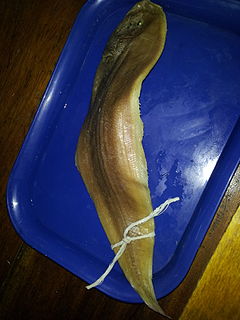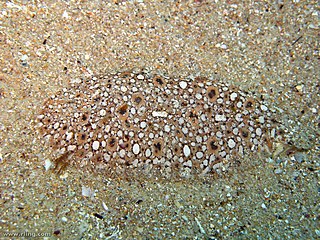
Mackerel is a common name applied to a number of different species of pelagic fish, mostly from the family Scombridae. They are found in both temperate and tropical seas, mostly living along the coast or offshore in the oceanic environment.

Herring are forage fish, mostly belonging to the family Clupeidae.

Carcharhiniformes, the ground sharks, with over 270 species, are the largest order of sharks. They include a number of common types, such as catsharks, swellsharks, and the sandbar shark.

The American soles are a family (Achiridae) of flatfish occurring in both freshwater and marine environments of the Americas. The family includes about 35 species in seven genera. These are closely related to the soles (Soleidae), and have been classified as a subfamily of it, but achirids have a number of distinct characteristics.

The true soles are a family, Soleidae, of flatfishes. It includes saltwater and brackish water species in the East Atlantic, Indian Ocean, and West and Central Pacific Ocean. Freshwater species are found in Africa, southern Asia, New Guinea, and Australia.

The Gonostomatidae are a family of mesopelagic marine fish, commonly named bristlemouths, lightfishes, or anglemouths. It is a relatively small family, containing only eight known genera and 32 species. However, bristlemouths make up for their lack of diversity with numbers: Cyclothone, with 13 species, is thought to be the most abundant vertebrate genus in the world, numbering in the hundreds of trillions to quadrillions.

Citharichthys is a genus of flatfish in the large-tooth flounder family, Paralichthyidae. They have both eyes on the left sides of their heads. They are native to the oceans around the Americas, with a single species, C. stampflii off the West African coast. Most are found in relatively shallow depths, but the genus also includes species found in deep water and species that enter fresh water.

Lobotes is a genus of perciform fishes known as the tripletails native to subtropical and tropical waters in all oceans. This is the sole genus in the family Lobotidae.

Tonguefishes are flatfish in the family Cynoglossidae. They are distinguished by the presence of a long hook on the snout overhanging the mouth, and the absence of pectoral fins. Their eyes are both on the left side of their bodies, which also lack a pelvic fin. This family has three genera with a total of more than 140 species. The largest reaches a length of 66 cm (26 in), though most species only reach half that size or less. They are found in tropical and subtropical oceans, mainly in shallow waters and estuaries, though some species are found in deep sea floors, and even a few in rivers.

Steindachneridion is a genus of South American pimelodid catfish.
Tridentopsis is a genus of pencil catfishes native to South America.

Gagata is a genus of sisorid catfishes native to Asia.

Idiotropiscis is a genus of pygmy pipehorse endemic to Australia. They are commonly called pygmy pipehorses due to their small size.

The Samaridae are a family, the crested flounders, of small flatfishes native to the Indo-Pacific. They were formerly classified as a subfamily of Pleuronectidae. The family contains four genera with a total of almost 30 species.

Lucania is a genus of North American ray-finned killifishes in the family Fundulidae. The genus can be found in northeastern Mexico and the southeastern and eastern parts of the United States, with L. parva ranging as far north as Massachusetts. They are mostly found in fresh water, although L. parva also is frequent in coastal brackish water. They are sometimes held in aquariums.

Fish are very diverse animals and can be categorised in many ways. This article is an overview of some of ways in which fish are categorised. Although most fish species have probably been discovered and described, about 250 new ones are still discovered every year. According to FishBase, 34,300 species of fish had been described as of September 2020. That is more than the combined total of all other vertebrate species: mammals, amphibians, reptiles and birds.

Thunnus (Thunnus) is a subgenus of ray-finned bony fishes in the Thunnini, or tuna, tribe. More specifically, Thunnus (Thunnus) is a subgenus of the genus Thunnus, also known as the "true tunas". Thunnus (Thunnus) is sometimes referred to as the bluefin group and comprises five species:

Pardachirus is a genus of soles mainly native to coastal water in the Indo-Pacific. A single species, P. poropterus is restricted to estuaries and lower sections of freshwater streams. At least some species in the genus are toxic.

















